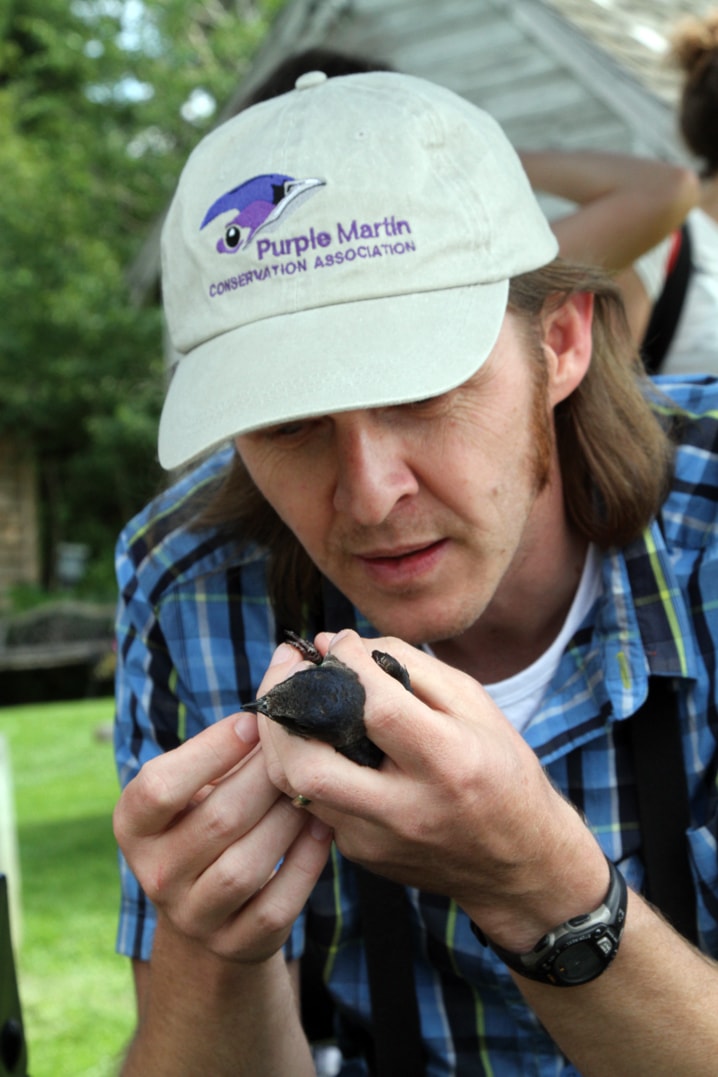After a 21,000-km journey, four purple martins returned to Ellis Bird Farm a year after they had been given geolocators.
Last summer, Kevin Fraser, who studies migratory bird behaviour at York University in Toronto, put the tracking devices on about 20 purple martins in the region, the northern most part of the birds’ range. He said it was the first time they had ever studied the migratory patterns of the swallow.
“We knew they probably spent their winters somewhere in South America but we didn’t really know specifically where,” said Fraser. “If you want to conserve a population of birds, you need to know where they are.”
Fraser was at the Ellis Bird Farm, located east of Blackfalds, Wednesday and Thursday as part of his scientific research.
The birds wintered in Brazil but had important stopovers, Texas being one, to refuel and fatten up for the next leg of their journey.
On an average day, the purple martins travelled 600 km.
“One bird we tracked last year was away from this breeding site for 263 days of the year,” said Fraser. “Most of it is not here, but we see the declines here.
“To understand what is going on that is contributing to the declines at the breeding site, we need to see what is going on during the rest of the year.”
Of those 20 that were tagged in the region, five returned this year, four of whom came back to Ellis Bird Farm. Fraser said this was a lower than normal return rate, which he said could be attributable to the variable weather this spring.
“Usually we get 40 to 50 per cent back,” said Fraser. “We think the low return rates we’re seeing everywhere have something to do with the really bad conditions. Right across North America, there were cold snaps and stormy weather.”
The hope with this year’s tracking is for a greater return of the martins. More birds will have the geolocators attached to them with 28 from Ellis Bird Farm and 66 for the region, mostly from the Camrose area.
The four that returned to Ellis Bird Farm were slated to get new geolocators so they can be tracked again to compare the migration patterns year-to-year.
Fraser has a particular interest in the northern limit of the purple martin’s range because that is where the population declines are most prevalent. He said there is a theory that the birds generally do not adjust their migration schedules and sometimes arrive in areas after peak food periods.
In order to put the geolocators on the birds and properly assess them, they were caught by setting a trap on a multi-birdhouse. Once inside, the door they chose to go in was blocked off and they were carefully put inside a cloth bag.
Fraser would then remove them from the bag and meticulously inspect them, measuring wingspan, claw length, taking a blood sample, feather sample and recording all the data for his scientific research.
Ellis Bird Farm manager and biologist Myrna Pearman said this research could easily be the most exciting thing to happen at the facility.
“People are very touched when they learn about the amazing migration of these birds,” said Pearman, who has been a biologist and an interpreter for about 30 years.
“I think there are two things people are the most interested in — seeing baby birds in a nest and learning about these purple martins and their migration.
“This is science in the making.”
mcrawford@www.reddeeradvocate.com
